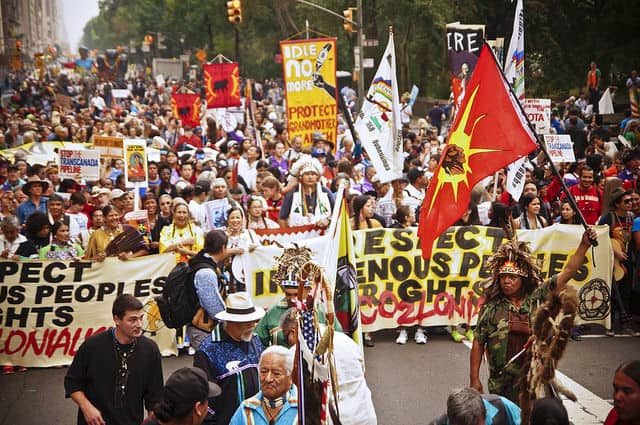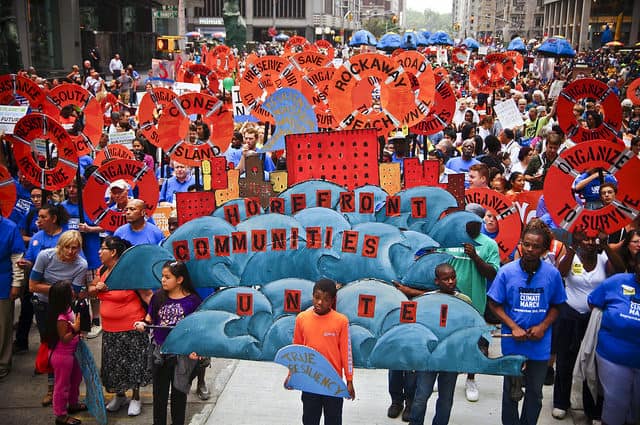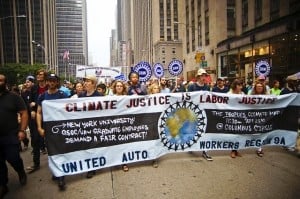For the past several months, I have received an avalanche of emails from several environmental organizations. They all had one goal – to get as many people involved in the People’s Climate March as they possibly could. I admit: I had some doubts and trepidations. I worried that the march might not gather enough people, or that it might be interpreted as a white, upper-class affair (a stereotype of environmental activism). These possibilities scared me because they would allow pundits and politicians to dismiss climate change as a non-issue, and continue their inaction on the matter. But beneath my doubts and hesitations, I found a deeper conviction: at this juncture, we need to act. We cannot risk sitting idly or dismissing climate change.
And so on Sunday, September 21, I marched with approximately 400,000 people. World leaders like United Nations General Secretary Ban Ki-Moon, French Ecology Minister Ségolène Royal, and New York Mayor Bill de Blasio attended. Celebrities such as Mark Ruffalo, Leonardo DiCaprio and Edward Norton marched with the crowd. The best part was: I couldn’t even see them. They were part of the mass of marching humanity, in a crowd so extensive that it was impossible to see in its entirety.
What’s more, the diversity of participants stretched beyond stereotypical boundaries. Environmental advocacy has a bad reputation as a bougie white person cause. Some think that those who tackle environmental issues have a little too much time and money on their hands, as distinct from those concerned with matters like unemployment, racism, or gender inequality. But these typical barriers fell down for at least one Sunday, when we all came to march: labor unions, civil rights groups, LGBTQ organizations, immigration advocates, farmers associations, and clergy swelled the ranks. We walked together in encounter and action.
* * *
The movement to tackle climate change has been building for a long time. In 1997, much of the world came together to ratify the Kyoto Protocol. The United States held back, seriously hampering the effectiveness of the treaty. Advocates built pressure, feeling the growing need for action. But the U.S. balked, concerned that the internationally-binding reform would mean for the economy, and jobs. Eight years ago, Al Gore’s An Inconvenient Truth caused an explosion of interest and renewed concern. Debates broke out over solar flares, global cooling, and melting ice caps. Then as now, the scientific community held near unanimity on the reality of human-caused climate change, but our political and popular culture preferred to label it a debatable topic.
As a socially-minded person, I quickly engaged the debates. I first became interested in environmental issues during high school. My geometry teacher George Mills led a chapter of Stream Team, an organization that helps groups adopt sections of rivers to clean and monitor water health levels. On our trips, we discussed how climate change would affect our adopted river’s oxygen and nitrogen components, as well as other health factors. Though I became a staunch advocate for fighting climate change, I consistently met fierce opposition from classmates. A high schooler at the time, I felt I could do little more than throw my hands up in frustration and grumble about the perceived stupidity of others.
Especially for persons my age, accustomed to quickly accomplishing tasks or solving problems, a 10-year battle for climate action can lead to despair and hopelessness. Moreover, I have found it particularly painful that groups I mutually support have acted against each other. Labor unions have not always fought against climate change, but instead many have resisted curbing emissions. Environmental protection and job protection/creation are often seen as competing goods. But on Sunday, thousands of workers marched to fight for their livelihoods and the children they love.
More people have come to recognize our present climate reality and the dangers it poses. Yet the battle still rages. We can finger point at liberals, conservatives, the media, government, individuals, or the Church for contributing to the pervasive inaction. That’s not the point. The point is that debate about climate change exists not because the science is inconclusive, but because we continue to ignore the realities that face us. For those fighting for change, apathy and denial can only yield hopelessness.
* * *
The night before the march, about thirty individuals — including Jesuits and those affiliated with our works: parishioners, students, and volunteers — gathered for prayer and discussion. Several people mentioned the fatigue brought on by fighting a seemingly lonely cause. Despite 97% scientific agreement on the causes of climate change,1 we continue to run headlong into rejection or disinterest. Surely Jesuits, those supporters of social justice and world betterment are at the forefront? Not always. In many of our communities, we find excuses to not do actions as simple as recycling. Jesuits, like everyone, struggle (and sometimes refuse) to change our lifestyles.
Part of the problem is the fact that we have been able to just ignore the issue. The Pacific Ocean is gradually subsuming little islands, but that’s far away. Glaciers are melting, okay, but what does that mean for me? Only recently, as our previously unaffected communities have been thrashed by unprecedented superstorms, has the question become more personal. Add to that food prices skyrocketing because of droughts, and people start to pay attention. But yet the will for change remains inconsistent.
Scaring people seems to have little positive effect, as Bloomberg News pointed out in April. Threats of losing all sometimes serve to make people feel more powerless, unable to tackle problems. George Marshall makes a good point in the Guardian as well that we do not have an enemy to rally against. In a world where we are the enemy by our own actions, acting on climate change becomes more difficult. And yet we know that we can no longer afford to sit by idly in light of the great challenges standing before us.
****
We can change the dialogue on climate change. We can build a future of hope and possibility. As stated by Cardinal Secretary of State Pietro Parolin, “There is no room for the globalization of indifference, the economy of exclusion or the throwaway culture so often denounced by Pope Francis.” He continued, “Talking about emission reductions is useless if we are not ready to change our lifestyle and the current dominant models of consumption and production.” We need a culture of hope, dialogue, and encounter. We need to know the poor whose lives are most threatened by climate change.
Feeling alone or hopeless can no longer be an option. As my good friend Tim once stated, “There is a hope and love burning inside me, an ever-expanding fire that cannot help but grow.” Our hope must be like the burning bush, aflame but never consumed. We must act out of love, goodness and encounter. We must acknowledge our personal and communal stake in acting. I am fighting climate change because I want to protect my prayer life: I am dependent on the beauty of God in the natural world for my spirituality. I am also standing up because God calls me to protect the least of our brothers and sisters.
We need everyone — with their various gifts, talents and identities — to act to renew the world in which we live. We need artists, lawyers, doctors, dancers, poets, activists, community organizers, farmers, industrial laborers, and teachers. We need you! We stand at a juncture where we must move to action. Our work will most assuredly fail if we do it from fear and worry. But if we act together for the burning hopes and dreams aflame inside us, then we shall succeed.
At the march, as I stood with the 400,000 marchers, I could not but help feel a sense of unity and strength. The march empowered us to act. It gave us the gifts of companionship, hope and life. Our unity in love for the gift of creation bound us together. What more strength and hope could I want? What more strength and hope could we need?
— // —
Cover photo, “Indigenous Marchers” by Light Brigading via Flickr.
- http://climate.nasa.gov/scientific-consensus/ ↩




